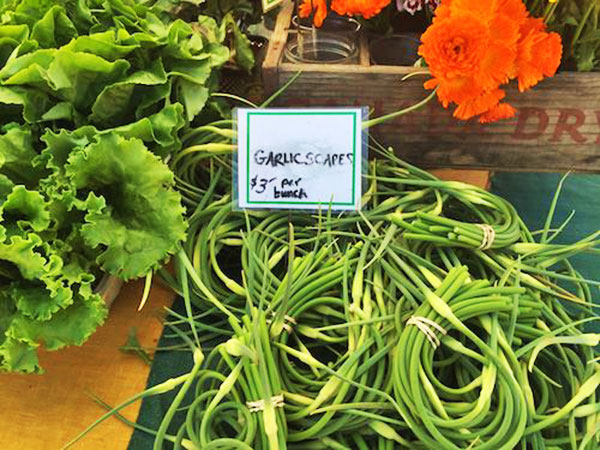|

by Kirsten K. Shockey
September
27, 2016
from
MotherEarthNews Website
|
Kirsten K. Shockey is a post-modern homesteader who
lives in the mountains of Southern Oregon.
She
writes about sauerkraut and life - but not necessarily
in that order.
She's written a complete book of
Fermented Vegetables
and forthcoming
Fiery Ferments and
maintains
the
website
Ferment.works. |

It was late Fall when most of the seed garlic was tucked into the
long rows that Mary Alionis, queen bee of
Whistling Duck farm, brought
nine varieties to my fermentation space in order to compare how the
different varieties react in ferments.
These were the players:
-
'Wonha'
-
'Chimayan'
-
'Siberian'
-
'Romanian Red'
-
'Kishlyk'
-
'Aglio Rosso di
Sulmona'
-
'Sliverskin'
-
'Creole'
'German Red',
...who'll you'll be
introduced to properly in just a moment.
Garlic Fermentation
Trials
We trialed each variety as a whole clove pickle that was fermented
in a brine and as a lacto-fermented paste which was dry fermented
with salt. It was fascinating to watch the process unfold.
After the first 4 days,
there was already a lot of fermentation action.
The brined garlic pickles had varying degrees of activity by
variety. The 'Chimayan', for example, bubbled all over the place
where as the 'German Red' showed little sign of fermentation. This
was also true of the pastes.
The 'Chimayan' was darker
while the 'German Red' showed the least color change. Some of the
other pastes were varying degrees of pink. The 'Creole' was the
bubbliest.
As the ferments progressed, each one went about its progression
through the stages at its own pace, despite all other factors being
the same.
But the real test was the
flavor. They were "technically" finished in about a month; however,
because of refrigeration constraints, I kept them in a root cellar
at around 58 degrees Fahrenheit for 5 months.
They were still delicious
and had incredible depth of flavor.
Results and
Tasting Notes
-
Wonha:
This garlic is an
Asiatic variety from North Korea, and while it is a hot and
spicy fresh garlic, it ended up being the best all-around
for its mild balance of flavor. The paste has a mild flavor
with sweetness, and the pickles have a wonderful floral
sweetness.
-
Chimayan:
These are rich
and earthy when fresh (and yes a big bulb with large
cloves). When fermented this garlic paste takes on an
herbal, spicy flavor. The pickled clove is sweet and the
brine is exceptionally fizzy.
-
Siberian:
The paste made
from this variety is smooth with fennel notes (I know odd,
but tasty). The fermented clove is spicy, not as sweet as
some of the other varieties. Strangely, it is also the only
one that seemed a bit fibrous.
-
Romanian Red:
This is a
productive, strong-flavored, fresh variety. Fermented, it
offers a nice balance of flavor. The paste has light citrusy
notes. The brined cloves are average flavored.
-
Kishlyk:
This garlic is
from Uzbekistan. It produces large bulbs, and the fresh
flavor is quite tasty. As a fermented garlic the final paste
is a caramel color with a pure sweetness. The pickled clove
is also very sweet.
-
Aglio Rosso di
Sulmona:
This garlic is
from the Abruzzo region of Italy and is known as a pickling
garlic. Fresh, it has a sweet delicate flavor. Interestingly
we found it to have a slightly bitter flavor (not unpleasant
but noticeable) in both the paste and the whole clove
pickle. The brine of the whole clove pickle is sweet and
syrupy and is one of the tastiest brines.
-
Silverskin:
One of the big
advantages to fermenting this garlic is the large bulb size
(less bulbs to peel). Another plus is its long storage
period so you can use it all through the winter and spring
in any ferment. The paste has a mild flavor at first with
heat that comes on slowly. The whole clove brine has a most
amazing rich flavor, while the cloves themselves were a
little boring (like all the flavor just dropped into the
brine).
-
Creole:
This garlic hails
from the Mediterranean and is an all around good garlic to
grow, store, and ferment. The paste has a light heat that
comes on slowly and the brined clove stays nice and spicy.
The brine itself is thick, sweet and syrupy.
-
German Red:
This is a
rocombole variety that is spicy when raw. It also has a very
nice scape that ferments
beautifully in a pickle or paste. The bulbs are also medium
to large which is handy for big production.

This variety
produces a very nice ferment with a clean garlic flavor in
both the paste and brined whole clove. The paste is sweet
and mild with a curry-yellow color.
It is time to plant garlic and any kind will give you an amazing
convenient probiotic condiment.
Check out a recipe
here...
|



